双端队列和双向广搜队列
双端队列
介绍
双端队列类似与dijkstra算法,用于求最短路,最短路中权值不是都为1,有1有0的时候可以用到双端队列。每次只要扩展到0那就把点加到对头,每次扩展到1就把点加到队尾。这样来保证bfs维护的队列的两段性和单调性。需要注意的是我们双端队列类似与dijkstra,我们出队的时候判重,因为出队的才是最小的那个距离。
题目
题目概述:
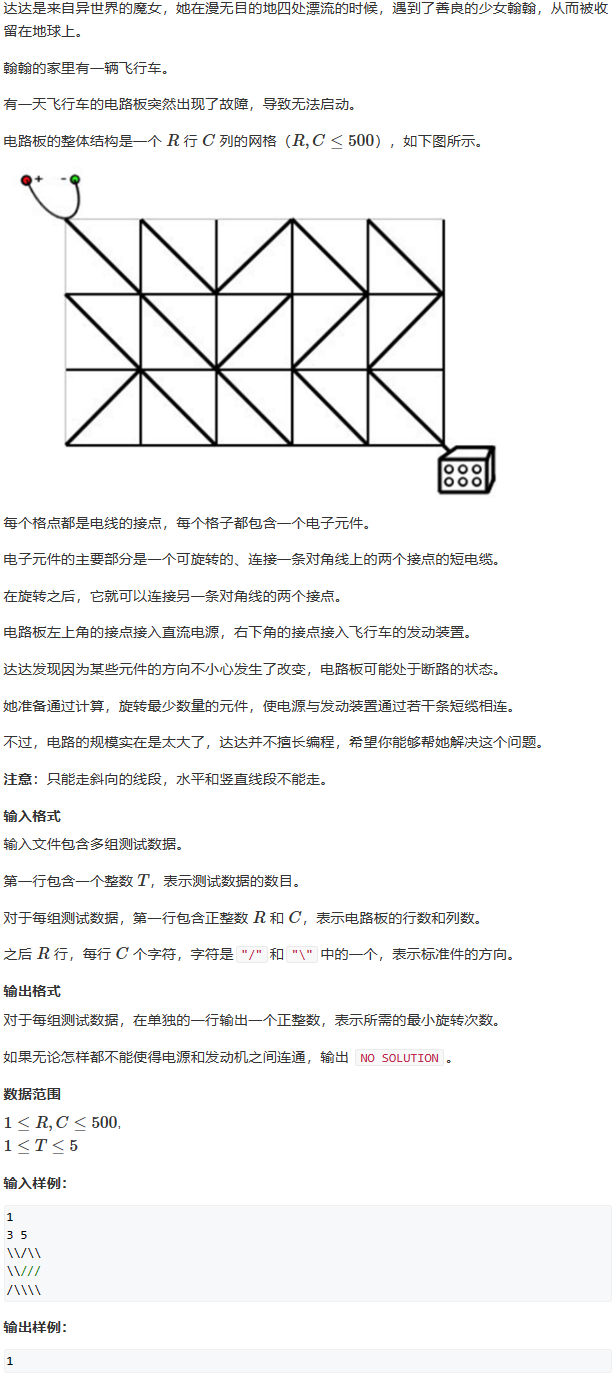
解题思路:
这个题目可以将每个格子的顶点看作是一个点,如果点和点之间有连接,那么它们之间的距离就是0.如果没有链接那距离就是1,所以可以把这个题目总结成图的最短路问题。我们可以用djkstra做也可以用双端bfs做。
双端bfs:
因为题目中存在0和1的边,边不是全都是1,我们如果遍历到0的边那么就往队列开头加,如果遍历到1的边就往队列后加。这样可以保证队列的两端性和单调性。其实就是bfs模拟堆优化版本的dijkstra。
注意:由于我们只能斜线走所以我们只能在x和y方向上做加一减一操作,我们的起点xy之和如果是奇数的话,那么之后只能走奇数点,我们起点是偶数的话那么我们就只能走偶数点。
这个题目需要出队的时候才确认是最小值,才会stu置true。
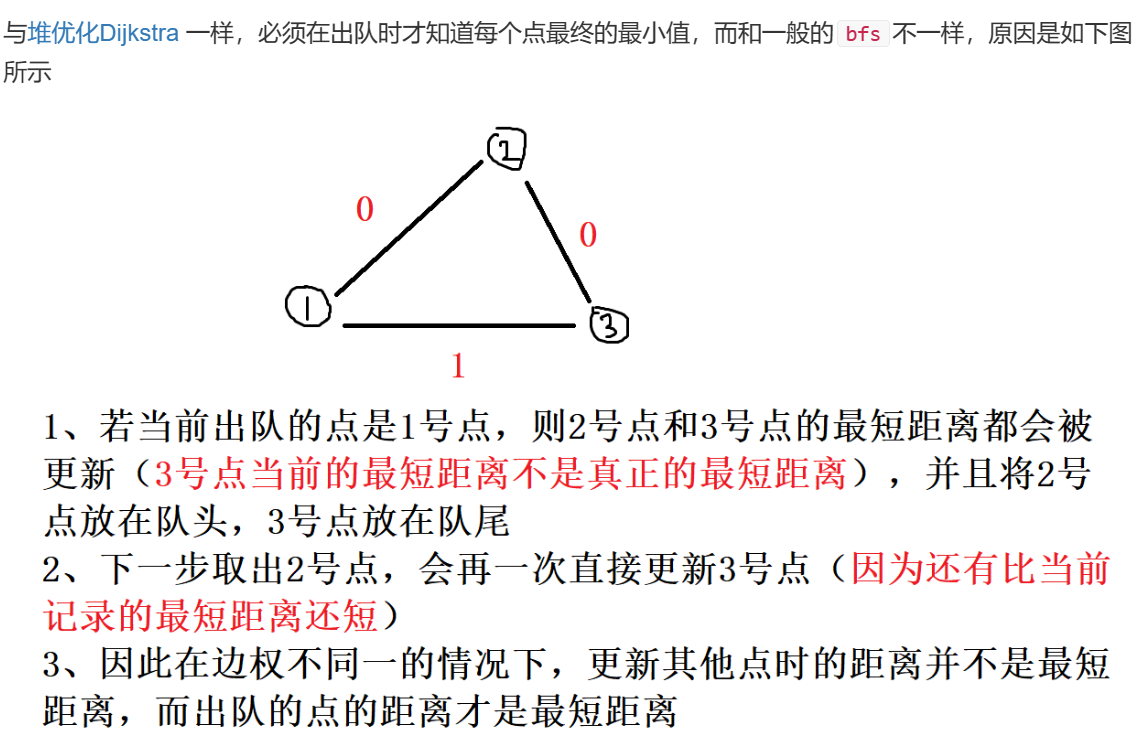
代码:
1
2
3
4
5
6
7
8
9
10
11
12
13
14
15
16
17
18
19
20
21
22
23
24
25
26
27
28
29
30
31
32
33
34
35
36
37
38
39
40
41
42
43
44
45
46
47
48
49
50
51
52
53
54
55
56
57
58
59
60
61
62
63
64
65
66
67
68
69
70
71
72
73
74
75
76
77
| import java.io.*;
import java.util.*;
class Main{
public static int N = 510;
public static char[][] cs = new char[N][N];
public static boolean[][] stu = new boolean[N][N];
public static Scanner sc = new Scanner(System.in);
public static void dfs(int r,int c){
if((r+c)%2 == 1){
System.out.println("NO SOLUTION");
return;
}
char[] step = {'\\','/','/','\\'};
int[] dx = {1,1,-1,-1},dy = {1,-1,1,-1};
int[] dxs = {0,0,-1,-1},dys = {0,-1,0,-1};
Deque<Pair> queue = new LinkedList<>();
queue.addLast(new Pair(1,1,0));
stu[1][1] = true;
while(!queue.isEmpty()){
Pair u = queue.removeFirst();
int x = u.x,y = u.y,d = u.d;
stu[x][y] = true;
if(x == r+1 && y == c+1){
System.out.println(d);
break;
}
for(int i = 0;i < 4;i++){
int tx = x + dx[i],ty = y + dy[i];
if(tx < 1 || ty < 1 || tx > r + 1 || ty > c + 1) continue;
if(stu[tx][ty]) continue;
if(cs[x+dxs[i]][y+dys[i]] == step[i]){
queue.addFirst(new Pair(tx,ty,d));
}
else{
queue.addLast(new Pair(tx,ty,d+1));
}
}
}
}
public static void main(String[] args){
int t = sc.nextInt();
while((t--)!=0){
int r = sc.nextInt(),c = sc.nextInt();
for(int i = 1;i <= r+1;i++){
Arrays.fill(stu[i],false);
}
for(int i = 1;i <= r;i++){
String s = sc.next();
for(int j = 1;j <= c;j++){
cs[i][j] = s.charAt(j-1);
}
}
dfs(r,c);
}
}
static class Pair{
int x,y,d;
public Pair(int x,int y,int d){
this.x = x;
this.y = y;
this.d = d;
}
}
}
|
双向广搜队列
介绍
双向广度优先搜索(Bidirectional Breadth-First Search)算法。这是一种在图或树中寻找最短路径的算法,其特点是从起点和终点同时进行广度优先搜索,直到两个搜索相遇。
以下是双向广度优先搜索的一般步骤:
- 初始化:
- 同时从起点和终点开始两个广度优先搜索。
- 给起点和终点分别分配一个起始层级(深度)为0的层。
- 交替进行搜索:
- 在每一轮中,从起点和终点分别向外扩展一层。
- 检查两个搜索的状态是否相遇。如果相遇,说明找到了一条路径。
- 判定相遇:
- 当两个搜索相遇时,可以根据实际需求确定路径的具体形式,例如,连接两个搜索的路径。
- 终止条件:
- 当其中一个搜索到达终点,或者两个搜索相遇时,算法可以终止。
双向广度优先搜索相对于单向广度优先搜索的优势在于,它可以有效地减小搜索空间,提高搜索效率,特别是在寻找最短路径时。它适用于那些有明确起点和终点的问题,例如迷宫求解、图的最短路径等。
如下图所示,灰色空间是我们单向的搜索空间,黑色是我们双向的搜索空间,双向搜索可以大大减少我们的搜索空间。
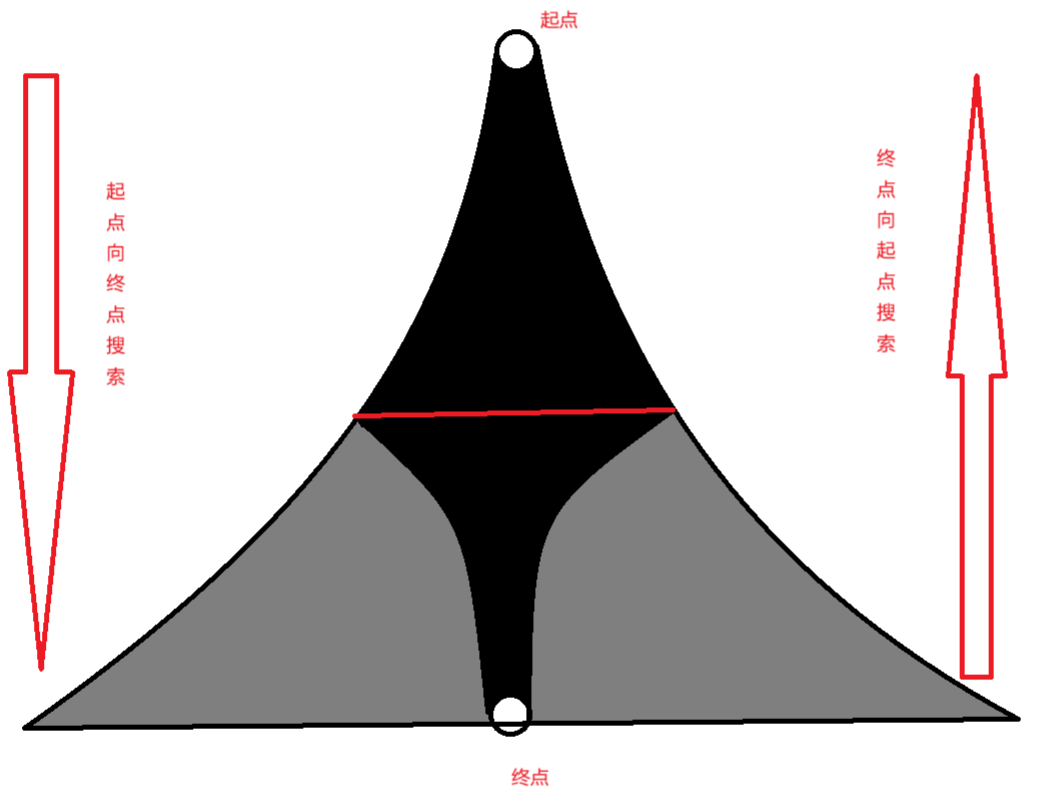
题目
题目概述
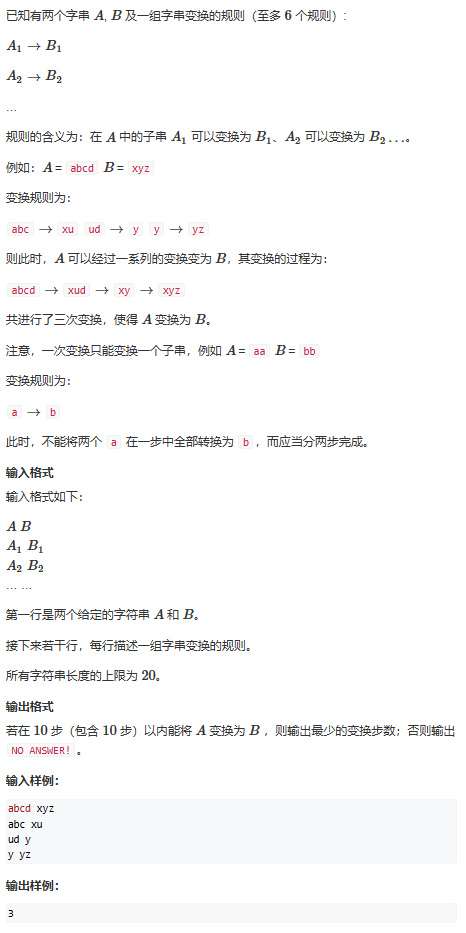
注意
本题如果每次每一边只扩展一个点了,但这样是不正确的。正确做法应该是每次每边扩展完整一层。
反例如下图所示:
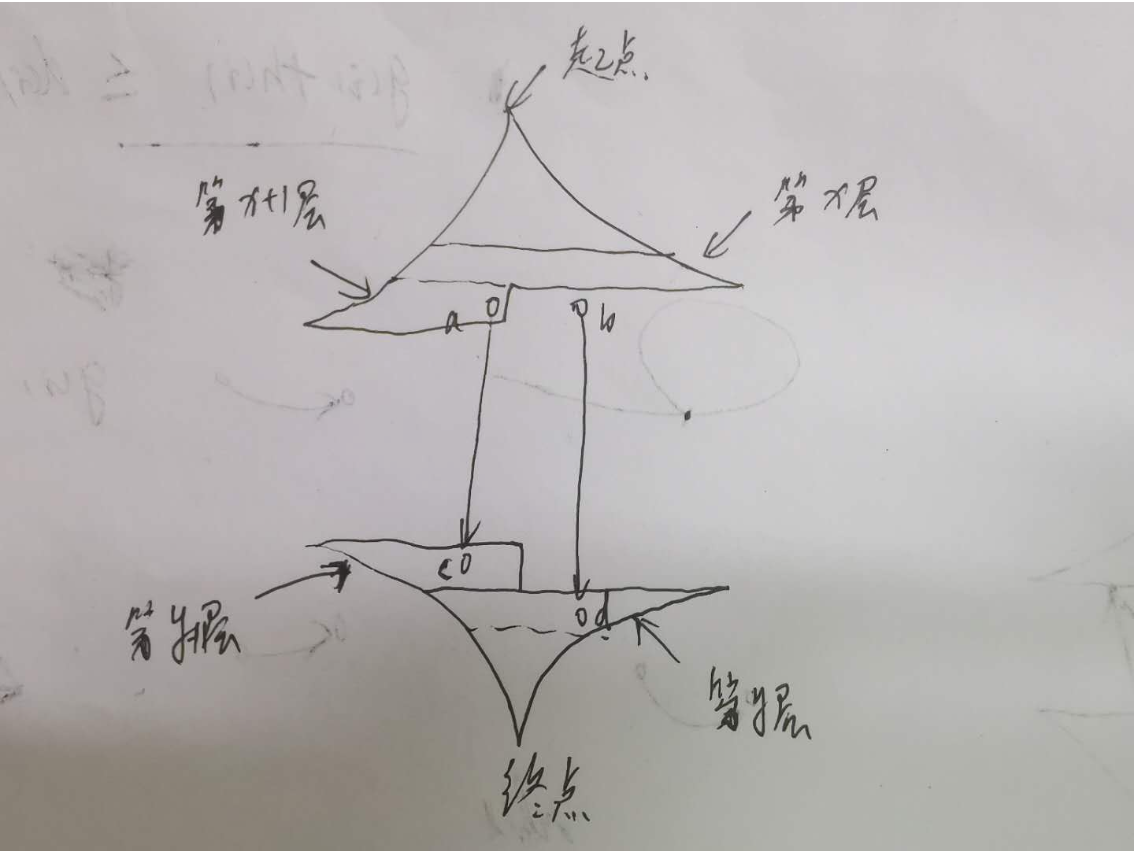
如上图,如果每次不是扩展完整一层,而是只扩展一个点。此时上面该扩展点 a了,点 a 搜到了下半部分的点 c,此时算出的最短路长度是 $$x+1+y+1+1=x+y+3$$但是最优解可能是后面还没扩展到的点 b和点 d之间的路径,这条路径的长度是$$ x+1+y+1=x+y+2$$。
解题代码
1
2
3
4
5
6
7
8
9
10
11
12
13
14
15
16
17
18
19
20
21
22
23
24
25
26
27
28
29
30
31
32
33
34
35
36
37
38
39
40
41
42
43
44
45
46
47
48
49
50
51
52
53
54
55
56
57
58
59
60
61
62
63
64
65
66
67
68
69
70
71
72
73
74
75
76
77
78
79
80
81
82
83
84
85
86
87
88
89
90
91
92
93
94
95
96
97
98
99
100
101
102
103
104
105
106
107
108
109
110
111
112
113
114
115
116
117
118
| import java.io.*;
import java.util.*;
class Main{
public static int N = 10,n;
public static String[] a = new String[N],b = new String[N];
public static Scanner sc = new Scanner(System.in);
public static HashMap<String,Integer> astu = new HashMap<>(),bstu = new HashMap<>(),da = new HashMap<>(),db = new HashMap<>();
public static int bfs(String start,String end){
if(start.equals(end)) return 0;
Queue<Pair> aqueue = new LinkedList<>(),bqueue = new LinkedList<>();
aqueue.add(new Pair(start,0));
astu.put(start,1);
da.put(start,0);
bqueue.add(new Pair(end,0));
bstu.put(end,0);
db.put(end,0);
while(!aqueue.isEmpty() && !bqueue.isEmpty()){
if(aqueue.size() <= bqueue.size()){
int dd = aqueue.peek().d;
while(!aqueue.isEmpty() && aqueue.peek().d == dd){
Pair u = aqueue.remove();
String s = u.s;
int d = u.d;
for(int i = 1;i <= n;i++){
for(int j = 0;j < s.length() - a[i].length() + 1;j++){
String temp = "";
if(s.substring(j,j+a[i].length()).equals(a[i])){
temp = s.substring(0,j) + b[i] + s.substring(j+a[i].length(),s.length());
if(!astu.containsKey(temp)){
if(bstu.containsKey(temp)){
return d+1+db.get(temp);
}
astu.put(temp,1);
aqueue.add(new Pair(temp,d+1));
da.put(temp,d+1);
}
}
}
}
}
}else {
int dd = bqueue.peek().d;
while(!bqueue.isEmpty() && bqueue.peek().d == dd){
Pair u = bqueue.remove();
String s = u.s;
int d = u.d;
for(int i = 1;i <= n;i++){
for(int j = 0;j < s.length() - b[i].length() + 1;j++){
String temp = "";
if(s.substring(j,j+b[i].length()).equals(b[i])){
temp = s.substring(0,j) + a[i] + s.substring(j+b[i].length(),s.length());
if(!bstu.containsKey(temp)){
if(astu.containsKey(temp)){
return d+1+da.get(temp);
}
bstu.put(temp,1);
bqueue.add(new Pair(temp,d+1));
db.put(temp,d+1);
}
}
}
}
}
}
}
return 11;
}
public static void main(String[] args) {
String start = sc.next(),end = sc.next();
while (sc.hasNext()){
a[++n] = sc.next();
b[n] = sc.next();
}
int res = bfs(start,end);
if( res > 10) System.out.println("NO ANSWER!");
else System.out.println(res);
}
static class Pair{
String s;
int d;
public Pair(String s,int d){
this.s = s;
this.d = d;
}
}
}
|





